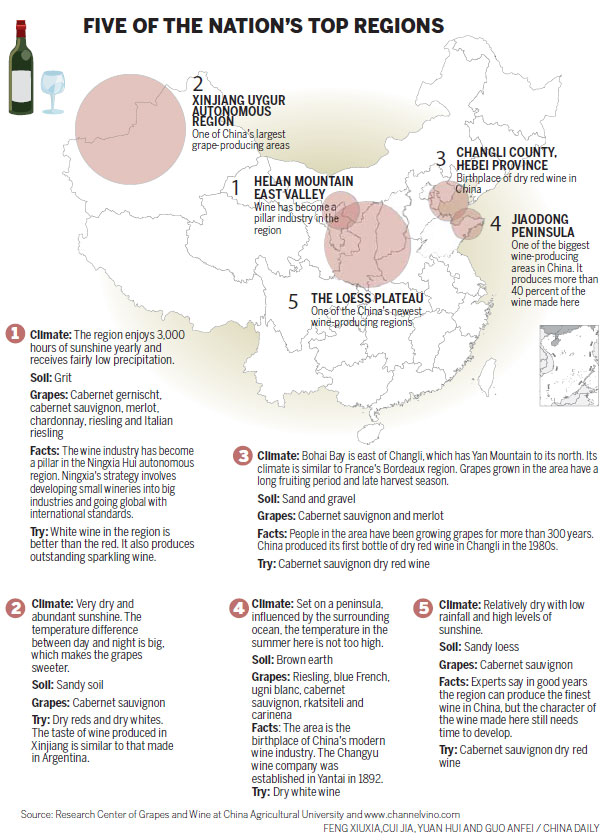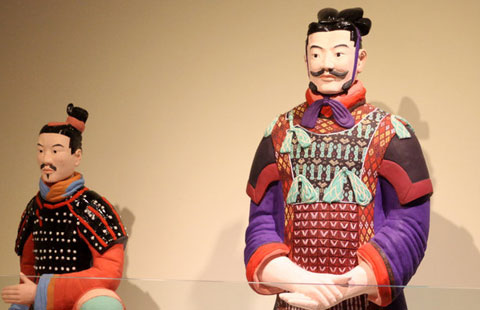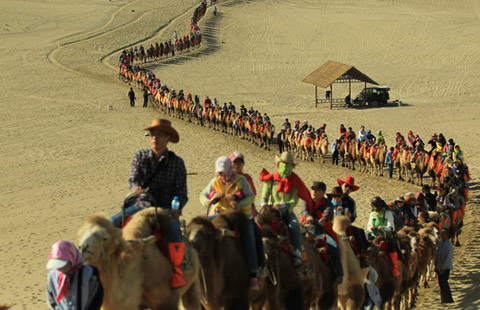
Domestic Producers say they can compete with top global brands
People in China drank more than 1.86 billion bottles of wine last year - 136 percent the amount consumed in 2008.
But most probably still know more about French wine regions such as Bordeaux than they do about domestic producers.
Now the owners of wineries across the country want to prove to customers at home and abroad that Chinese wine can be just as versatile and full of personality as top international brands.
They are confident that soon enthusiasts will want to order a bottle of cabernet sauvignon from the Xinjiang Uygur autonomous region to go with a steak, or a glass of chardonnay from the Ningxia Hui autonomous region to accompany fish.
China, which produced its first bottle of dry red wine in the 1980s, has established 10 wine production regions, each with its own character.
"Wine is like Chinese food, it has so many flavors and everyone can find his or hers," says Duan Changqing, director of the Research Center of Grape and Wine at China Agricultural University in Beijing.
Wine has been made in China since the explorer Zhang Qian traveled west in 138 BC. He returned with information about winemaking techniques, and also brought back people who possessed the necessary expertise.
Winemaking reached its peak during the Tang Dynasty (AD 618-907) as the country's economy boomed. Historical documents show that Li Shimin, a Tang emperor, greatly enjoyed wine.
Li expanded his territory to include what is now Xinjiang's Turpan area, which was famous for its grapes. He acquired details of a local method for making wine, which was later served at banquets.
"The wine industry often flourishes when a country's economy is relatively developed," Duan says. "China's past and present have proved this theory."
Most Chinese wines are sold domestically, but Duan believes they will eventually become a popular choice for customers in other countries, just like Chinese food.
"The characters of Chinese wines produced in different regions have become more stable, and the quality has been improving steadily."
The established large corporations have realized that as Chinese customers acquire more knowledge they tend to favor wines that have unique characteristics rather than those that come from giant production plants.
Many small wineries that were built five or six years ago have started to produce fine wines, and their number has been growing.
"They hold the key to the future of China's wine industry," Duan says.
Silver Heights, a winery in the Ningxia Hui autonomous region, comes highly recommended by international wine masters such as Jancis Robinson and Robert Parker.
Its founder, Gao Lin, built the concrete-walled cellar at Silver Heights' first vineyard himself.
It lacks modern ventilation or dehumidification equipment. But this is where Gao, along with his 37-year-old daughter, Emma Gao, a winemaker who graduated from Bordeaux University's Institute of Oenology, and his son-in-law, Thierry Courtade, also a winemaker at Bordeaux's Chateau Calon-Segur, have produced wine since 2007.
"People don't care about how good your cellar looks, they actually visit you to find how good your wines are," Gao says.
"We started like a garage cellar, small in plantation and production scale, but producing delicate and top-quality wines."
Silver Heights has thrived on that philosophy, building up its brand and winning international awards. Spanish distributor Torres China supplies its products to 82 luxurious hotels and five-star Aman resorts in China, alongside grands crus such as 1982 Chateau Lafite. Silver Heights now tends 40 hectares of vines.
Yet this success story is just one of many that the Helan Mountain East Valley, an ambitious wine region protected by state certification of origin, has to offer the world.
Situated at latitude 38 degrees north, the region's average elevation is 1,100 meters above sea level. It enjoys 3,000 hours of sunshine yearly and has low rainfall of about 600 mm during the growing season.
The Yellow River has washed through the Helanshan Mountain region for millions of years, bringing rich minerals and porous gray desert soil.
This favorable terroir, the French term for an area's special characteristics, produces good grapes that have low vulnerability to disease. The resulting wines have won more than 100 international prizes, and the region has been accepted as an observer by the International Organization of Vine and Wine.
Cao Kailong, director of the Ningxia Grape and Flower Industries Development Bureau, says the region will be harvesting more than 70,000 hectares of grapes by 2020.
"There are already 100 established wineries, and another 100 wineries have completed or are now going through the registration process," Cao says.
"The region's strategy is to develop small wineries but a big industry, going global with international standards and fostering local brands."
Cao says most of the 2,000 wineries that are expected to be operating by 2020 will have small-scale production levels of 150,000 to 200,000 bottles a year.
"It's like calligraphy. Everyone has his own style. We help wineries to become special and develop their own characters that can compete with top international brands."
Leading international players such as Pernod Ricard and Domaine Chandon are among those growing grapes and making wines in a region that "warmly welcomes" foreign investors.
Shen Yang, estate director of Domaine Chandon's Ningxia operation, says the debut of the wines in September was a great success. The company is redesigning the label and from the second batch onward it will include the words "Made in Helan Mountain East Valley" in Chinese and English.
"We want Chinese consumers to be proud of products made in China," Shen says. "The origin label will promote our Chandon brand too. We are proud to tell everyone that the wine is from Helan Mountain."
As well as international producers, investors from China have also shown great interest in the industry.
In Shanxi province many people whose wealth came from the coal industry have ditched their old businesses and set their sights on opening wineries. Zhang Wenquan, president of Chateau Rongzi, is one of them.
He has found there are many advantages for energy enterprises that shift to wine since he established the chateau in 2007.
"The capital accumulated in the energy industry to some extent ensures the high quality of facilities, which paves the way for the use of advanced technology in the winemaking process, and therefore fine wine can be produced," he says. "It is also environmentally friendly and can benefit local farmers."
The provincial government has introduced policies aimed at changing the industrial landscape, which is based mainly on coal mining, to boost the economy in an environmentally friendly way. This has encouraged a growing number of coal companies to invest in vineyards.
Shanxi belongs to one of China's emerging wine-producing regions, the Loess Plateau. At about 800 to 1,200 meters above sea level with a continental climate, the main wine-producing areas in the province lie on roughly the same latitudes as Bordeaux.
Low rainfall, high levels of sunshine, a temperature difference of 15 C between day and night and sandy soil all contribute to the quality of the grapes.
"In good years this region could produce the finest wine in China," Duan says.
To guarantee the quality of the wines, Rongzi uses Italian and French pressing machines and bottling equipment.
Nevertheless, the Chinese still predominately prefer to consume traditional alcoholic drinks rather than wine. Baijiu, a white spirit, is often served during formal occasions and traditional festivals.
Wang Qingwei, general manager of Chateau Rongzi, says: "With low alcohol by volume, wine will be a better choice for many people at business events where drinking almost cannot be avoided.
"We can encourage customers to change their drinking habits and adopt a healthier way of consuming alcohol, and this will help wine to gain popularity."
Sales in China dropped sharply in the first half of this year as a result of the central government's campaign to ban officials' lavish lifestyles, Duan says.
"Wine is still seen as a luxury product rather than a daily consumption item in China. In the past, some people did not appreciate the value of wine," he says.
"They bought expensive wines just to impress or even bribe officials. Now those buyers are gone, but this is a good thing, as now the wine market can begin to develop in a healthier way."
Wineries have positioned themselves as local tourist attractions to promote the wine culture and boost sales.
Zhang Hanzhe, a 17-year-old senior middle school student, was impressed with the Changyu Wine Culture Museum in Shandong province, a traditional winemaking area. He visited the museum during his summer vacation in August.
"I had never thought that China has such a wonderful history of winemaking," he says. "Before, I tended only to link wine from European countries.
"It was a great experience to learn about the whole production process in the museum. I also learned a lot about how to appreciate wine."
Zhang bought a bottle with a label printed with a photo of his family as a gift for his mother.
"She will love this personalized gift very much," he says.
Located in Yantai, the museum was established in 1992 at the former site of Changyu, China's first industrialized wine manufacturer.
It has become a popular tourist destination, and visitors can see the cellar, taste premium wines and have wine appreciation lessons. Hong Yuyan, a manager of the Changyu Tourism Company, says about 300,000 tourists visit the museum every year.
Nestled between the blue waters of Bohai Bay and the sprawling mountain ranges along Shandong's northern coast, Yantai is the only city in Asia to be honored as an International Grape and Wine City by the International Organization of Vine and Wine.
It is said that Zhang Bishi, an overseas Chinese businessman in Southeast Asia, selected Yantai to build the Changyu winery in 1892 because he heard about the coastal city from French friends, who said the city's climate and sunshine were ideal for making wine.
The city produced 14.85 million liters of wine in the first half of this year, accounting for 29.2 percent of the country's total production, according to the Yantai Grape and Wine Bureau.
Yi Fenghuang, head of the bureau, says 152 winemakers are planning operations in Yantai, including heavyweights Changyu, Junding, Great Wall and Grand Dragon.
About 50 chateaus have been built in Yantai as the industry has developed. They have boosted wine tourism, which helps people to understand wine.
Visitors to chateaus in Yantai can tour vineyards and visit the cellar stores and workshops. At Chateau Changyu Castel, tourists can participate in picking grapes during the harvest season and make wines themselves.
Lin Chengcai, office director of the Yantai Grape and Wine Bureau, says a million tourists visit the city's chateaus every year.
Contact the writers at cuijia@chinadaily.com.cn
Wang Huazhong, Zhao Ruixue, Zhang Yu and Cheng Hong contributed to this story.
|
Tourists visit the wine storage room at the Changyu Wine Culture Museum in Yantai, Shandong province. The museum has attracted numerous visitors since it opened to the public in 1992. Zhu Xingxin / China Daily |
|
Staff members display wines made by the Changyu company at Chateau Changyu Castel in Yantai, Shandong province, during a promotional event. Zhu Xingxin / China Daily |

(China Daily Africa Weekly 10/10/2014 page14)








